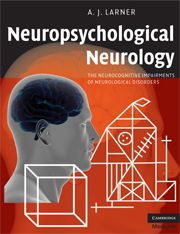Book contents
- Frontmatter
- Contents
- Acknowledgements
- Introduction
- 1 Cognitive function, neuropsychological evaluation, and syndromes of cognitive impairment
- 2 Neurodegenerative disorders
- 3 Cerebrovascular disease: vascular dementia and vascular cognitive impairment
- 4 The epilepsies
- 5 Neurogenetic disorders
- 6 Inflammatory, immune-mediated, and systemic disorders
- 7 Structural brain lesions
- 8 Endocrine, metabolic, and toxin-related disorders
- 9 Infective disorders
- 10 Neuromuscular disorders
- Index
- References
7 - Structural brain lesions
Published online by Cambridge University Press: 15 December 2009
- Frontmatter
- Contents
- Acknowledgements
- Introduction
- 1 Cognitive function, neuropsychological evaluation, and syndromes of cognitive impairment
- 2 Neurodegenerative disorders
- 3 Cerebrovascular disease: vascular dementia and vascular cognitive impairment
- 4 The epilepsies
- 5 Neurogenetic disorders
- 6 Inflammatory, immune-mediated, and systemic disorders
- 7 Structural brain lesions
- 8 Endocrine, metabolic, and toxin-related disorders
- 9 Infective disorders
- 10 Neuromuscular disorders
- Index
- References
Summary
Brain tumours and their treatment
Cognitive decline in patients with brain tumours may have many causes, including the tumour itself, concurrent tumour-related seizures, mood disorder, steroid therapy, and as a sequel of surgery, radiotherapy, and chemotherapy for the tumour, or any combination thereof (Taphoorn & Klein, 2004). Cognitive decline related to the tumour per se may be more common with certain tumour types (CNS lymphoma, gliomatosis cerebri) and with slowly, as opposed to rapidly, growing tumours (Tucha et al., 2000). Dominant as opposed to non-dominant hemisphere lesions may be associated with greater cognitive deficit, but the profile is more global than localized. Lesions located in specific eloquent structures (hippocampus, frontal lobes, fornix) may produce specific deficits. Longitudinal neuropsychological decline may be an early marker of tumour recurrence (Armstrong et al., 2003).
Meningiomas
Meningiomas have a predilection for certain intracranial sites, including the olfactory groove, falx, parasagittal region, and sphenoid bone, in some of which there may be prominent cognitive as well as focal neurological signs. Meningioma is recognized to be a potentially treatable cause of dementia (Erkinjuntti et al. 1987; Sahadevan et al., 1997).
- Type
- Chapter
- Information
- Neuropsychological NeurologyThe Neurocognitive Impairments of Neurological Disorders, pp. 178 - 187Publisher: Cambridge University PressPrint publication year: 2008



